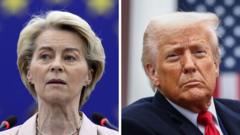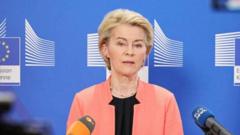The European Union is reassessing its trade strategy as U.S. tariffs threaten its market access. While there are signs of rekindled discussions with China, the ramifications could lead to either a partnership or greater discord.
The Potential Shifts in EU-China Relations Amidst American Tariffs

The Potential Shifts in EU-China Relations Amidst American Tariffs
As President Trump's tariffs escalate, the EU finds itself at a crossroads with China, pondering whether to embrace deeper ties or face increased tensions.
The recent imposition of President Trump's tariffs has left many companies in the European Union reevaluating their business models, particularly as the United States solidifies its position as the world's foremost consumer market. As they seek alternative trading partners, all eyes are on China.
The EU stands as the second-largest consumer market globally, with China following closely. However, the relationship between the two has been fractious, marked by European criticisms of China's overproduction and their handling of international affairs, such as the war in Ukraine. In light of potential 20% tariffs across the board in the U.S. and even steeper levies on crucial sectors like automotive, Europe's companies are feeling the pressure to pivot.
Despite a history of tension, there are emerging signs of thawing relations. The EU recently upped tariffs on Chinese electric vehicles, yet China has signaled a willingness to rekindle negotiations, prompting discussions on electric vehicle supply chains and pricing strategies.
However, there’s a significant risk that increased competition from China could exacerbate tensions. If Chinese firms find their access to American consumers hindered, they may aim to deepen their presence in Europe with cheap products, possibly heightening existing concerns over unfair trade practices. As noted by Theresa Fallon from the Center for Russia, Europe, Asia Studies, the EU’s current situation is precarious, forcing it to navigate these complex geopolitical waters with caution.
Europe's future trade landscape hangs in the balance, with the potential for both collaboration with China or further estrangement as global trade patterns shift in response to U.S. policies.
The EU stands as the second-largest consumer market globally, with China following closely. However, the relationship between the two has been fractious, marked by European criticisms of China's overproduction and their handling of international affairs, such as the war in Ukraine. In light of potential 20% tariffs across the board in the U.S. and even steeper levies on crucial sectors like automotive, Europe's companies are feeling the pressure to pivot.
Despite a history of tension, there are emerging signs of thawing relations. The EU recently upped tariffs on Chinese electric vehicles, yet China has signaled a willingness to rekindle negotiations, prompting discussions on electric vehicle supply chains and pricing strategies.
However, there’s a significant risk that increased competition from China could exacerbate tensions. If Chinese firms find their access to American consumers hindered, they may aim to deepen their presence in Europe with cheap products, possibly heightening existing concerns over unfair trade practices. As noted by Theresa Fallon from the Center for Russia, Europe, Asia Studies, the EU’s current situation is precarious, forcing it to navigate these complex geopolitical waters with caution.
Europe's future trade landscape hangs in the balance, with the potential for both collaboration with China or further estrangement as global trade patterns shift in response to U.S. policies.






















